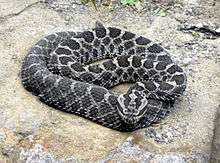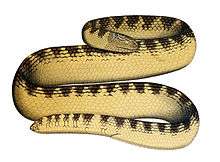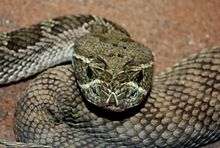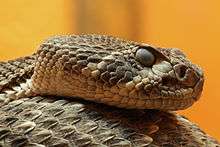Evolution of snake venom
.jpg)
| Part of a series on |
| Evolutionary biology |
|---|
 |
|
History of evolutionary theory |
|
Fields and applications
|
|
Venom in snakes and some lizards is a form of saliva that has been modified into venom over its evolutionary history.[1][2] In snakes, venom has evolved to kill or subdue prey, as well as to perform other diet-related functions.[3] The evolution of venom is thought to be responsible for the enormous expansion of snakes across the globe.[4][5][6]
The evolutionary history of snake venom is a matter of debate. The common view of this history prior to 2014 was that venom originated just once among all Toxicofera approximately 170 million years ago, and then diversified into the wide range of venoms seen today.[4] Under this hypothesis, the original toxicoferan venom was a very simple set of proteins that were assembled in a pair of glands. Subsequently, this set of proteins diversified in the various lineages of toxicoferans, including Serpentes, Anguimorpha, and Iguania.[3] Several snake lineages subsequently lost the ability to produce venom, often due to a change in diet.[4]
The single-origin hypothesis suggests that the mechanism of evolution in most cases has been gene duplication followed by natural selection for adaptive traits.[3] Some of the various adaptations produced by this process include venom more toxic to specific prey in several lineages,[7][8][9] proteins that pre-digest prey,[10] as well as a method to track down prey after a bite.[11] These various adaptations of venom have also led to considerable debate about the definition of venom and venomous snakes.[4]
The idea that venom had a single evolutionary origin has been called into question by a 2015 study, which found that venom proteins had homologs in many other tissues in the Burmese python.[12] The study therefore suggested that venom had evolved independently in a number of snake lineages.
Evolutionary history
Until the use of gene sequencing to create phylogenetic trees became practical, phylogenies were created on the basis of morphology. Such traditional phylogenies suggested that venom originated in multiple branches among Squamata approximately 100 million years ago.[4] More recent studies using nuclear gene sequences, have found the presence of similar venom proteins in several lizards within the Toxicoferans, demonstrating that venom originated only once within the entire lineage approximately 170 million years ago. This ancestral venom consisted of a very simple set of proteins, assembled in a pair of glands.[4] The venoms of the different lineages then diversified and evolved independently, along with their means of injecting venom into prey.[4]
The origin of venom is thought to have provided the catalyst for the rapid diversification of snakes in the Cenozoic period,[4] particularly to the Colubridae and their colonization of the Americas.[5] Scholars suggest that the reason for this huge expansion was the shift from a mechanical to a biochemical method of subduing prey.[6]
The venom system has also subsequently atrophied, or has been completely lost, independently in a number of lineages. The American “rat snakes,” such as Pantherophis guttatus, lost their venom following the evolution of constriction as a means of prey capture. The independent evolution of constriction in the fish-eating genus Acrochordus also saw the degradation of the venom system. Two independent lineages, one terrestrial and one marine, that shifted to an egg-based diet, also possess the remnants of an atrophied venom system.[4]
The view that venom evolved just once has recently been called into doubt. A team led by Todd Castoe at the University of Texas at Arlington found that homologs of the so-called "toxic" genes were present in numerous tissues of a non-venomous snake, the Burmese python. Castoe stated that the team had found homologs to the venom genes in many tissues outside the oral glands, where venom genes might be expected. This demonstrated the weaknesses of only analyzing transcriptomes. The team suggested that pythons represented a period in snake evolution before major venom development. The researchers also found that the expansion of venom gene families occurred mostly in highly venomous caenophidian snakes. Therefore, the authors suggested that instead of evolving just once in an ancestral reptile, snake venom evolved independently in a number of lineages.[12][13]
Mechanisms of evolution
The primary mechanism for the diversification of venom is thought to be the duplication of genes coding for other tissues, followed by their expression in the venom glands. The proteins then evolved into various venom proteins through natural selection. This process, known as the birth-and-death model, is responsible for several of the protein recruitment events in snake venom.[3] These duplications occurred in a variety of tissue types with a number of ancestral functions. Notable examples include 3FTx, ancestrally a neurotransmitter found in the brain, adapted into a neurotoxin that binds and blocks acetylcholine receptors. Another example is phospholipase A2 (PLA2) type IIA, ancestrally involved with inflammatory processes in normal tissue, that has evolved into venom capable of triggering lipase activity and tissue destruction.[4] The change in function of PLA2, in particular, has been well documented; there is evidence of several separate gene duplication events, often associated with the origin of new snake species.[14] Non-allelic homologous recombination has been proposed as the mechanism of duplication of PLA2 genes in rattlesnakes.[15] These venom proteins have also occasionally been recruited back into tissue genes.[3] Gene duplication is not the only way that venom has become more diverse. There have been instances of new venom proteins generated by alternative splicing. The Elapid snake Bungarus fasciatus, for example, possesses a gene that is alternatively spliced to yield both a venom component and a physiological protein.[3] Further diversification may have occurred by gene loss of specific venom components. For instance, the rattlesnake ancestor is believed to have had genes for neurotoxic PLA2 toxins, which are absent in modern non-neurotoxic Crotalus species.[15]
There have been debates about whether the original gene duplication events occurred in a salivary gland or in body tissues themselves. The prevailing idea for many years is the birth-and-death model described above, in which genes in other body tissues are duplicated and then recruited to the venom gland prior to undergoing natural selection for toxicitiy.[16] However, in 2014 a new model was proposed in which salivary protein genes are duplicated and then restricted to the venom gland.[1] This model does away with the recruitment hypothesis and cites the homology between certain venom and body genes as unrelated in the linear fashion described in the traditional birth-and-death model.[1]
Some traditional hypotheses of snake venom evolution have supported the idea that most snakes inject far more venom into their prey than is required to kill them; thus, venom composition would not be subject to natural selection. This is known as the "overkill" hypothesis.[7] However, recent studies of the molecular history of snake venom have contradicted this, instead finding evidence of rapid adaptive evolution in many different clades, including the genera Echis [7] and Sistrurus ,[17] as well as generally in the diversification of PLA2 proteins.[14] However, the genus Agkistrodon has been found to be an exception to this; the composition of venom in Agkistrodon has been found to be related to the position of the species within the phylogeny, suggesting that those venoms have evolved mostly through neutral evolutionary processes.[18]
Prey-specific venom toxicity
Recent research has found several examples of snake venoms that are more toxic to specific prey species that dominate a particular snake's diet. Prominent examples include the genera Echis and Sistrurus. Evidence for a similar process of adaptation has been found among the subfamily Hydrophiinae, which contain most sea snakes.
Echis

The natural diet of the widespread viper genus Echis includes arthropods, such as scorpions; however, various Echis species consume different proportions of arthropods in their diet.[7] A study carried out in 2009 injected scorpions with the venom of various Echis species. The researchers found that there was a high correlation between the proportion of arthropods that the snakes naturally consumed, and the toxicity of their venom to scorpions.[7] The researchers also stated that there was evidence that the shift in venom composition was related to the shifts in diet, and that diet and venom may have evolved by a process of coevolution. A phylogeny of the genus constructed using mitochondrial DNA showed that one instance of a change in venom composition in the ancestral species was related to a shift to an arthropod based diet, whereas another shift in a more recent lineage was correlated with a shift to a diet of vertebrates.[7] Despite the increased toxicity of arthropod-consuming species' venom, it was not found to be faster to cause incapacitation or death, suggesting an alternative fitness benefit: the venom was thought to have evolved to minimize the volume required, as the production of venom carries a significant metabolic cost,[7] a pattern also found in other lineages.[3] Similar results were obtained by a 2012 study which found that the venom of arthropod-consuming Echis species was more toxic to locusts than that of vertebrate-consuming species.[19]
Sistrurus

A similar correlation between venom and diet has been demonstrated in the genus Sistrurus. A 2009 study injected mice, lizards and frogs with the venom of four Sistrurus species, and found that although the venom of all four was toxic to lizards and mildly toxic to frogs, there was significant variation in the toxicity to mice.[17] This variation was related to the proportion of small mammals in the diet of those species.[17] The idea that Sistrurus venom had evolved to accommodate a mammal-based diet was supported by phylogenetic analysis. The researchers suggested that the basis for the difference in toxicity was the difference in muscle physiology in the various prey animals.[17] There is phylogenetic evidence of positive selection and rapid rates of gene gain and loss in venom genes of Sistrurus taxa feeding on different prey.[20]
Hydrophiinae

The effect of diet as a factor driving evolution is also visible in sea snakes. Two lineages of elapid snakes, common sea snakes and Laticauda, have independently colonized marine environments, and shifted to a very simple diet based on teleosts, or ray-finned fish.[9] A 2005 study found that both these lineages have a much simpler set of venom proteins as compared to their terrestrial relatives on the Australian continent, which have a more varied and complex diet.[9] These findings were confirmed by a 2012 study, which compared the venoms of Toxicocalamus longissimus, a terrestrial species, and Hydrophis cyanocinctus, a marine species, both within the subfamily Hydrophiinae. Despite being closely related to one another, the marine species had a significantly simpler set of venom proteins.[8]
Marbled sea snake
Diet dependent evolution of venom has also been found in the marbled sea snake, Aipysurus eydouxii. A 2005 study found that the gene for a three-fingered protein found in the venom had undergone a deletion of two nucleotide bases which made the venom 50-100 times less toxic than it had been previously. This change was correlated with a change in diet from fish to a diet consisting almost entirely of fish eggs. The researchers also stated that this loss of venom demonstrated that snakes used venom chiefly for hunting, and not for defense or competition.[9]
Toxicity and pre-digestion of prey

The toxicity of venom to specific prey has been the most studied result of venom evolution; however, there are other examples of diet-related adaptations produced by the same process that have received less attention.
The various subspecies of the rattlesnake genus Crotalus, produce venoms that carry out two functions. The venom immobilizes prey after a bite, and also helps digestion by breaking down tissues before the snake eats its prey.[10] As with other members of the family Viperidae, the venoms of Crotalus disrupt the homeostatic processes of prey animals. However, there is a wide variety of venom compositions among the species of Crotalus. A 2010 study found a 100-fold difference in the amount of metalloproteinase activity among the various snakes, with Crotalus oreganus cerberus having the highest activity and Crotalus oreganus concolor having the lowest. There was also a 15-fold variation in the amount of protease activity, with C. o. concolor and C. o. cerberus having the highest and lowest activities, respectively.[10]
Metalloproteinase activity causes hemorrhage and necrosis following a snake bite, a process which aids digestion. The activity of proteases, on the other hand, disrupt platelet and muscle function and damage cell-membranes, and thus contribute to a quick death for the prey animal.[10] The study found that the venoms of Crotalus fell into two categories; those that favored metalloproteinases (Type I) and those that favored proteases (Type II). The study stated that these functions were essentially mutually exclusive; venoms had been selected for based on either their toxicity or their tenderizing potential. The researchers also hypothesized that the reason for this dichotomy was that a venom high in neurotoxicity, such as a type II venom, kills an animal quickly, preventing the relatively slower acting metalloproteinase from digesting tissue.[10]
Tracking bitten prey

Another example of an adaptive function other than prey immobilization is the role of viperid venom in allowing the snake to track a prey animal it has bitten, a process known as "prey relocalization." This important adaptation allowed rattlesnakes to evolve the strike-and-release bite mechanism, which provided a huge benefit to snakes by minimizing contact with potentially dangerous prey animals.[11] However, this adaptation then requires the snake to track down the bitten animal in order to eat it, in an environment full of other animals of the same species. A 2013 study found that western diamondback rattlesnakes (Crotalus atrox) responded more actively to mouse carcases that had been injected with crude rattlesnake venom. When the various components of the venom were separated out, the snakes responded to mice injected with two kinds of disintegrins. The study concluded that these disintegrin proteins were responsible for allowing the snakes to track their prey.[11]
Notes and references
References
- 1 2 3 Hargreaves, Adam D.; Swain, Martin T.; Hegarty, Matthew J.; Logan, Darren W.; Mulley, John F. (2014-08-01). "Restriction and Recruitment—Gene Duplication and the Origin and Evolution of Snake Venom Toxins". Genome Biology and Evolution. 6 (8): 2088–2095. doi:10.1093/gbe/evu166. ISSN 1759-6653. PMC 4231632
 . PMID 25079342.
. PMID 25079342. - ↑ "Reptile Venom Research". Australian Reptile Park. Retrieved 21 December 2010.
- 1 2 3 4 5 6 7 Casewell et al. 2013.
- 1 2 3 4 5 6 7 8 9 10 Fry et al. 2012.
- 1 2 Wuster et al. 2008.
- 1 2 Lomonte et al. (a) 2014.
- 1 2 3 4 5 6 7 Barlow et al. 2009.
- 1 2 Calvete et al. 2012.
- 1 2 3 4 Li et al. 2005.
- 1 2 3 4 5 Mackessy 2010.
- 1 2 3 Saviola et al. 2013.
- 1 2 Reyes-Velasco, Jacobo; Card, Daren C.; Andrew, Audra L.; Shaney, Kyle J.; Adams, Richard H.; Schield, Drew R.; Casewell, Nicholas R.; Mackessy, Stephen P.; Castoe, Todd A. (2015-01-01). "Expression of Venom Gene Homologs in Diverse Python Tissues Suggests a New Model for the Evolution of Snake Venom". Molecular Biology and Evolution. 32 (1): 173–183. doi:10.1093/molbev/msu294. ISSN 0737-4038.
- ↑ "UT Arlington team proposes new model for snake venom evolution - UTA News Center". www.uta.edu. Retrieved 2016-10-16.
- 1 2 Lynch 2007.
- 1 2 Dowell, Noah L.; Giorgianni, Matt W.; Kassner, Victoria A.; Selegue, Jane E.; Sanchez, Elda E.; Carroll, Sean B. "The Deep Origin and Recent Loss of Venom Toxin Genes in Rattlesnakes". Current Biology. 26 (18): 2434–2445. doi:10.1016/j.cub.2016.07.038.
- ↑ Fry, Bryan G. (2005-03-01). "From genome to "venome": Molecular origin and evolution of the snake venom proteome inferred from phylogenetic analysis of toxin sequences and related body proteins". Genome Research. 15 (3): 403–420. doi:10.1101/gr.3228405. ISSN 1088-9051. PMC 551567
 . PMID 15741511.
. PMID 15741511. - 1 2 3 4 Gibbs & Mackessy 2009.
- ↑ Lomonte et al. (b) 2014.
- ↑ Richards, D. P.; Barlow, A.; Wüster, W. (2012-01-01). "Venom lethality and diet: Differential responses of natural prey and model organisms to the venom of the saw-scaled vipers (Echis)". Toxicon. 59 (1): 110–116. doi:10.1016/j.toxicon.2011.10.015.
- ↑ Gibbs, H. Lisle; Rossiter, Wayne (2008-02-06). "Rapid Evolution by Positive Selection and Gene Gain and Loss: PLA2 Venom Genes in Closely Related Sistrurus Rattlesnakes with Divergent Diets". Journal of Molecular Evolution. 66 (2): 151–166. doi:10.1007/s00239-008-9067-7. ISSN 0022-2844.
Sources
- Fry, B.G.; Casewell, N.R.; Wuster, W.; Vidal, N.; Young, B.; Jackson, T. N. W. (2012). "The structural and functional diversification of the Toxicofera reptile venom system". Toxicon. 60 (4): 434–448. doi:10.1016/j.toxicon.2012.02.013. PMID 22446061.
- Barlow, A.; Pook, C.E.; Harrison, R.A.; Wuster, E.W. (2009). "Coevolution of diet and prey-specific venom activity supports the role of selection in snake venom evolution". Proceedings of the Royal Society B: Biological Sciences. 276 (1666): 2443–2449. doi:10.1098/rspb.2009.0048. PMC 2690460
 . PMID 19364745.
. PMID 19364745. - Calvete, J.J.; Ghezellou, P.; Paiva, O.; Matainaho, T.; Ghassempour, A.; Goudarzi, H.; Kraus, F.; Sanz, L.; Williams, D.J. (2012). "Snake venomics of two poorly known Hydrophiinae: Comparative proteomics of the venoms of terrestrial Toxicocalamus longissimus and marine Hydrophis cyanocinctus". Journal of Proteomics. 75 (13): 4091–4101. doi:10.1016/j.jprot.2012.05.026. PMID 22643073.
- Casewell, N.R.; Wuster, W.; Vonk, F.J.; Harrison, R.A.; Fry, B.G. (2013). "Complex cocktails: the evolutionary novelty of venoms". Trends in Ecology & Evolution. 28 (4): 219–229. doi:10.1016/j.tree.2012.10.020.
- Gibbs, H.L.; Mackessy, S.P. (2009). "Functional basis of a molecular adaptation: Prey-specific toxic effects of venom from Sistrurus rattlesnakes". Toxicon. 53 (6): 672–679. doi:10.1016/j.toxicon.2009.01.034. PMID 19673082.
- Li, M.; Fry, B.G.; Kini, R.M. (2005). "Eggs-only diet: Its implications for the toxin profile changes and ecology of the marbled sea snake (Aipysurus eydouxii)" (PDF). Journal of Molecular Evolution. 60 (1): 81–89. doi:10.1007/s00239-004-0138-0. PMID 15696370.
- Lomonte, B.; Fernandez, J.; Sanz, L.; Angulo, Y.; Sasa, M.; Gutierrez, J. M.; Calvete, J. J. (2014). "Venomous snakes of Costa Rica: Biological and medical implications of their venom proteomic profiles analyzed through the strategy of snake venomics". Journal of Proteomics. 105: 323–339. doi:10.1016/j.jprot.2014.02.020.
- Lomonte, B.; Tsai, W. C.; Urena-Diaz, J. M.; Sanz, L.; Mora-Obando, D.; Sanchez, E. E.; Fry, B.G.; Gutierrez, J. M.; Gibbs, H. L.; Sovic, M.G.; Calvete, J.J. (1995). "Venomics of New World pit vipers: Genus-wide comparisons of venom proteomes across Agkistrodon". Journal of Proteomics. 96: 103–116. doi:10.1016/j.jprot.2013.10.036. PMID 24211403.
- Lynch, V.J. (2007). "Inventing an arsenal: adaptive evolution and neofunctionalization of snake venom phospholipase A(2) genes". BMC Evolutionary Biology. 7 (1): 2. doi:10.1186/1471-2148-7-2. PMC 1783844
 . PMID 17233905.
. PMID 17233905. - Mackessy, Stephen P. (2010). "Evolutionary trends in venom composition in the Western Rattlesnakes (Crotalus viridis sensu lato): Toxicity vs. tenderizers". Toxicon. 55 (8): 1463–1474. doi:10.1016/j.toxicon.2010.02.028. PMID 20227433.
- Saviola, A.J.; Chiszar, D.; Busch, C.; Mackessy, S.P. (2013). "Molecular basis for prey relocation in viperid snakes". BMC Biology. 11 (1): 20. doi:10.1186/1741-7007-11-20.